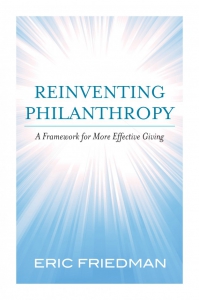Philanthropists Are Giving Ineffectively: Review of Eric Friedman’s Book Reinventing Philanthropy

Reinventing Philanthropy gets under your skin like a dentist’s advice to floss. You know in your head you should do it but don’t always feel like taking the time.
Eric Friedman simply wants giving to be effective. What does that mean? He wants people to engage in thinking critically about the world’s greatest needs and our best solutions. He is frustrated. “Giving is too often about making the donor feel better and too infrequently about making those in need better” (12). So Friedman wants to reinvent philanthropy and make the new normal—utilitarian, issue-agnostic donors who support charities offering “the greatest help to the greatest number of people” (182).
How does Friedman motivate donors to practice high-impact philanthropy?
Do-Gooders VS. Do-Besters
Reinventing Philanthropy splits the entire genus of givers into two species: do-gooders and do-besters. The utilitarian dichotomy permeates the book as approaches to giving are slotted on one side or the other. Do-gooders need emotional connections to causes they support. Do-besters are emotionally satisfied whenever the most critical needs are addressed with the most effective solutions. Do-gooders believe every cause is equally worthy while do-besters are ready to rank-order them (think Copenhagen Consensus here). Do-gooders give to what interests them, even if it prioritizes donkey sanctuaries over saving poor children’s lives. Do-besters focus on the world’s poorest countries, measure results, and make informed judgments. Which one do you want to be?
To support his call to do-bester philanthropy Friedman inserts a number of smart giving guidelines throughout the book. When it comes to measuring grantee performance, he admonishes, “[A]n inability to measure impact perfectly is not an excuse for not making an attempt to measure it at all” (85). He acknowledges many charities don’t know if their programs are effective long-term. “[C]harities often run programs for decades without knowing how well they work” (94). Do-besters don’t support charities flying blind.
As Friedman moves from principles to practice, he reminds us of the “opportunity cost” for every giving decision (151). He challenges us to “proactively search” for the best charities since “organizations with the greatest impact are unlikely to be top of mind” (160). And he understands giving well takes work. “Evaluating the many different causes, organizations, and projects takes a tremendous amount of time and effort.” These realities to finding and funding high-impact charities are a good reminder to any inexperienced giver trying to go to the next level in effective philanthropy.
In making his case Friedman is not afraid to take swipes at charities, philanthropic advisors, foundations or movements stuck in do-gooder ruts. He questions the cost-effectiveness of St. Jude’s Hospital. He calls out Rockefeller Philanthropy Advisors for taking no stand on which issues are most critical to address. He even critiques the modern trend toward “strategic philanthropy.” From his perspective, so what if Tom Siebel reduced Meth use in Montana through philanthropy? Friedman asks, “[W]ould the donation have been better spent reducing meth usage in a different state, supporting education, or providing health care in the developing world?” (62) Effective programs that accomplish a philanthropist’s mission of solving a real problem in the world only reflect a “better” way of being a “do-gooder” for Friedman. Do-besters, on the other hand, let facts inform both the cause and geography they select and not just the most effective implementation (see chapter 7). That is probably the most concrete and fresh critique of the philanthropy sector in the entire book.
Can Philanthropy’s Ultimate Questions Get Answered?
Reinventing Philanthropy surfaces philanthropy’s thorniest ethical questions. Should we prioritize “the well-being of one set of people over others” or just help wherever a proven solution is applied to a need? Should you donate to help one kid in the USA survive or prevent the deaths of 10 Burmese kids you will never meet? Are all good causes equally good? Should the emotional connection of donors play a role in deciding where to give or only the world’s greatest needs? Should anyone prioritize giving to the arts over saving children’s lives?
If you want to get Friedman’s answer to philanthropy’s toughest ethical questions, you might be disappointed. At multiple points throughout the book he remains non-committal. He sums up the reason for it quite clearly, “It is extremely subjective and challenging for donors to develop views on [which effective initiatives to support]” (94). In his conclusion he reiterates the point: “[T]here is a significant amount of subjectivity in determining [the most cost-effective solutions]” (183). In his chapter on “Measuring Performance,” he considers it “a judgment call whether a donor prefers to save lives or lift people from poverty.” Relegating these tough decisions to subjective judgment not only avoids answering questions he raises but nearly undercuts the meaningfulness of raising tough questions do-besters have to answer. I do not mean to imply he should have all the answers but only that readers may come away feeling like he has presented an impractical and unattainable ideal. In fact, Friedman acknowledges at the end of the book that the do-bester approach is “only a dream, a vision donors can try to make progress toward, but will never truly achieve” (184). Calling people to something they cannot do will be unsatisfying for readers like myself who resonate deeply with his desire to give effectively.
Do-bester Philanthropy Appears Impractical (but we can help!)
Friedman acknowledges giving well takes more time and energy than most people can commit. Writing about how to choose a charity in chapter 10, “This eight-principle checklist can be daunting for many donors, as it would be difficult to research all of these areas, let alone find organizations that pass all eight tests with flying colors” (116). When discussing how to gauge values alignment with grantees, Friedman advises, “[T]alk with senior staff to find out how the organization makes decisions about priorities. …Ask deep, open-ended questions that require thoughtful responses and see the direction they take to answer your questions” (107). Who has time to complete all this homework on top of their job, family commitments, personal care, community involvement, etc.?
From my perspective, the book justifies the burgeoning industry of philanthropic advisors, of which I am a part at Excellence in Giving. Friedman’s recommendation for donors to evaluate nonprofit impact measurement methods (chapter 8), follow 8 giving principles (chapter 10) and employ 10 smart approaches like determining the marginal impact of your donation (chapter 14) is too much for most people’s capacity. Friedman admits, “This may be the most damning of the four criticisms [of the do-bester approach]” (179). He ultimately concludes, “The solution: Get someone else to do the hard work” (180). He should have included our phone number at that point!
Similarly, when Friedman bemoans the lack of publicly available “principles, standards, or methods for evaluating the quality of a charity” (106), he apparently does not know his wish has already been granted at Nonprofit Analytics (I apologize for the blatant self-promotion here). Although much of his book reads like a promotional piece for Givewell.org, Givewell has not provided clear standards others can use. Nonprofit Analytics lists 34 specific charity health & performance indicators including multiple data points on results and how they are measured. Nonprofit Analytics will collect all the data on a donor’s behalf and essentially provide the expertise of foundation staff for the cost of a couple hardback philanthropy books. Too bad Friedman hadn’t found this resource before he wrote chapter 5 on “The Paucity of Helpful Information.” (FYI, we have spoken on the phone since he finished the book to discuss the resources we offer and how his bold questions are so good for our sector to hear!)
Who Will Like This Book?
On the lighter side, Friedman’s book will appeal to philanthropic engineers, academics, accountants and mathematicians. His “Axis of Altruism” graph plots how giving decisions can hurt or help yourself and hurt or help others to greater or lesser degrees. Readers will run into a dozen x- and y-axis altruism graphs throughout the book. Friedman’s “Law of Mission Impact” formulates how “impeding constraints” in a philanthropic mission statement reduce impact. If you limit your giving to your community, schools you attended, or medical issues affecting your family, those “personal preferences” are likely maintained “at the expense of impact on others” (59). I won’t spoil the equation for you here, but it’s intended to show that “giving $100,000 with a significantly constrained mission may not do as much good as giving $10,000 to one of the most impactful areas” (67).
If you want to read about a few thought-provoking philanthropic case studies on both the private foundation and charity sides of the equation, you will enjoy some fresh material. I personally fell out of my seat when I read the quote from Rockefeller Philanthropy Advisors defending Donkey Sanctuaries as a legitimate gift recipient on par with preventing child starvation. However, if you want a well-ordered book with dynamic stories and coherent sequence, you may not enjoy the ride. The ideas and advice repeat themselves. The chapter order splits the discussion on emotional giving 10 chapters from a discussion of selfish giving. The chapter on Measuring Performance is separated from the chapter on Choosing a Charity, and the intervening chapter “Examples of Do-Besters” is not tied directly to the use of the eight principles recommended for Choosing a Charity. It can get a bit confusing from the reader’s perspective.
How is the Book Most Useful?
I don’t mean to come down to hard on a book I truly enjoyed. The opening chapters wrestled with the same questions I face every day as a philanthropic advisor, and Friedman is admirably humble when he asks tough questions about how to give more effectively. His candor is refreshing. In the opening paragraphs he reflects, “I felt like a bit of a jerk, as I criticized well-intentioned, compassionate people.” In the second to last paragraph, he reminds his readers, “I don’t have all the answers on how it should be done.” In that vain, I appreciated how he stirred up the pot but invites all voices and practitioners to continue improving philanthropy. The book may not provide a fully developed and practical path to follow toward effective philanthropy, but Reinventing Philanthropy does raise the questions we must face while finding our own.
Go to Blog Home





Add Your Comments
Reader Comments
0 comments